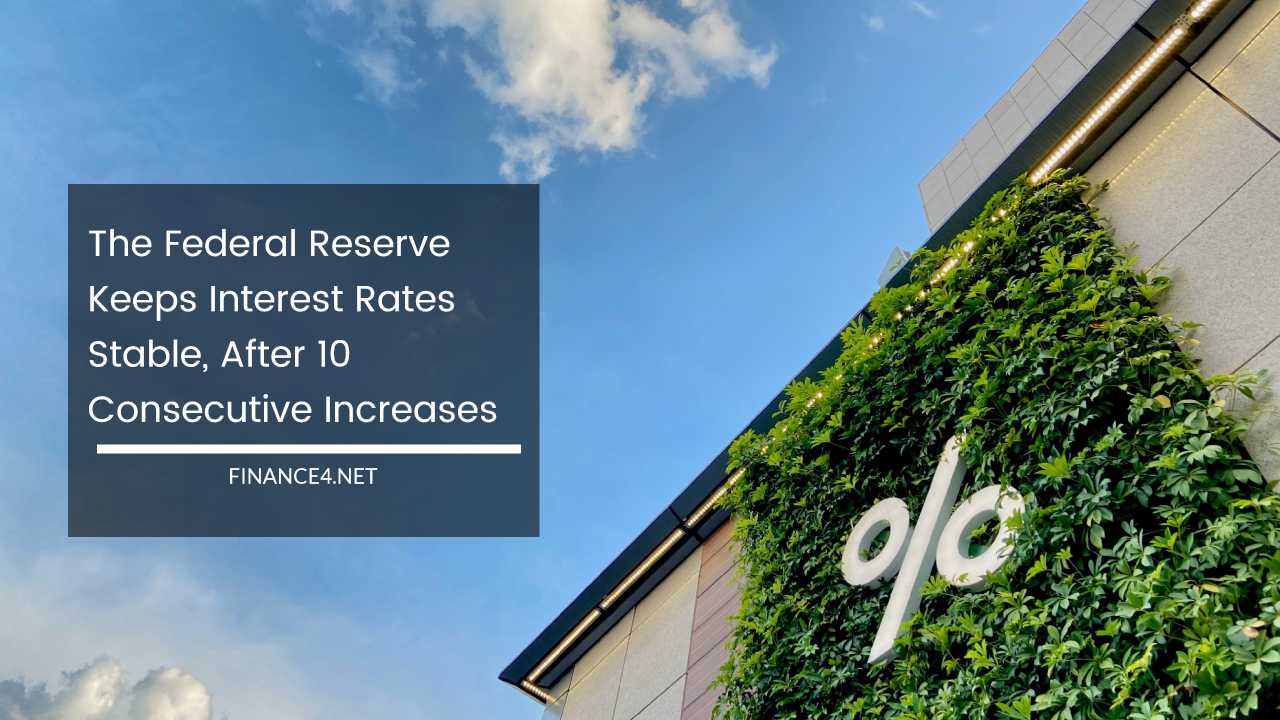The Federal Reserve Keeps Interest Rates Stable, After 10 Consecutive Increases

Interest Rates
In a significant development, the US Federal Reserve made an announcement on Wednesday declaring the suspension of its remarkable streak of interest rate hikes.
Instead, the central bank decided to maintain the current interest rates and monitor their impact on the broader economy before making any further adjustments.
The decision to refrain from a rate hike during this particular meeting was supported unanimously by the Federal Reserve’s voting members.
This collective agreement underscores the careful approach taken by the central bank in assessing the ongoing economic conditions and the potential repercussions of any policy changes.
By pausing the series of interest rate increases, the Federal Reserve aims to allow sufficient time for the effects of previous hikes to permeate through various sectors of the economy.
This deliberate approach seeks to strike a balance, ensuring stability while carefully evaluating the impact of previous monetary decisions.
The unanimous vote reflects a consensus among the members of the Federal Reserve, highlighting their unified stance on the current state of the economy and the necessity to gauge the efficacy of previous policy actions.
This decision marks a notable moment in the trajectory of interest rates, indicating the Federal Reserve’s cautious approach towards future adjustments and their commitment to closely monitoring economic trends before implementing further changes.
Starting from March 2022, the Federal Reserve officials have consecutively increased the benchmark interest rate on ten occasions, aiming to moderate the US economy and combat inflation, which remains double the target set by the central bank.
Following their meeting, the Federal Reserve released a statement affirming that the decision to pause the rate hikes is deemed prudent by officials.
However, it is worth noting that most officials still anticipate the need for additional rate hikes later in the year, as indicated in the Federal Reserve’s latest Summary of Economic Forecasts.
This acknowledgment underscores the Federal Reserve’s cautious approach, recognizing the importance of balancing economic growth and inflationary pressures.
While the current pause in rate hikes is viewed as a prudent step, officials are mindful of the possibility of further adjustments in the future to address evolving economic conditions and achieve their inflation targets.
The statement released by the Federal Reserve emphasized that keeping the rates unchanged during this meeting enables the Committee to thoroughly evaluate incoming information and its potential implications for monetary policy. This approach reflects their commitment to a data-driven decision-making process.
Based on the assessments of most officials, it is estimated that the federal funds rate will reach its peak between 5.63% and 5.87% in 2023.
This projection indicates that there is likely to be at least one more rate hike within the current year, with the exact number of increases contingent upon the magnitude of each adjustment.
These projections highlight the Federal Reserve’s forward-looking perspective, taking into account a range of factors and economic indicators to determine the appropriate course of action.
By closely monitoring the data and adjusting interest rates accordingly, the Federal Reserve aims to strike a balance between supporting sustainable economic growth and ensuring price stability.
The path of future policy decisions hinges on the forthcoming economic indicators over the upcoming weeks and months, with particular attention given to the robustness of the job market.
Currently, payroll growth remains robust, accompanied by wage gains, which exert upward pressure on prices.
Prominent economists argue that the tight labor market will persist as a persistent source of inflation, necessitating a rebalancing to align with the central bank’s 2% target.
Among the members of the Federal Open Market Committee, responsible for setting monetary policy, a majority anticipates the unemployment rate to increase within a range of 4-4.1% throughout this year.
This projection acknowledges the dynamic nature of the labor market and its significant influence on inflationary pressures.
As the Federal Reserve assesses these factors, it will consider the relationship between employment, wage growth, and inflation in determining the appropriate course of action.
By closely monitoring developments in the job market and other relevant economic indicators, the Federal Reserve aims to promote a stable and sustainable economic environment while working towards achieving its inflation and employment objectives.
In addition to monitoring economic indicators and the labor market, officials are closely observing the evolution of credit conditions, particularly in the regional banking sector.
There are some ongoing concerns regarding strains within this sector. It is noteworthy that banks have tightened their credit standards this year, and this trend is anticipated to persist.
If American consumers face challenges in accessing credit to support their lifestyles, especially considering the accumulation of debt in recent months, it is expected to have an impact on spending habits.
Economists suggest that as the focus shifts towards spending on services, Americans may reduce their purchases of goods. This observation reflects the interplay between credit availability, consumer behavior, and the broader economic landscape.
According to the statement, tighter credit conditions for both households and businesses are anticipated to exert a dampening effect on economic activity, hiring, and inflation. However, the exact magnitude of these effects remains uncertain and will require ongoing assessment.
Officials project that the personal consumption price index (PCPI), a key measure of inflation, will continue to hover slightly above the central bank’s target of 2% in 2024. However, it is expected to take until 2025 for the PCPI to fully reach the 2% threshold.
This forecast acknowledges the persistence of certain factors influencing inflationary pressures and the time required for them to be appropriately addressed.
The Federal Reserve will continue to closely monitor economic developments and assess the impact of credit conditions, among other factors, on the broader economic landscape.
Adjustments to monetary policy will be made based on these observations to support the achievement of the central bank’s inflation and employment objectives.



